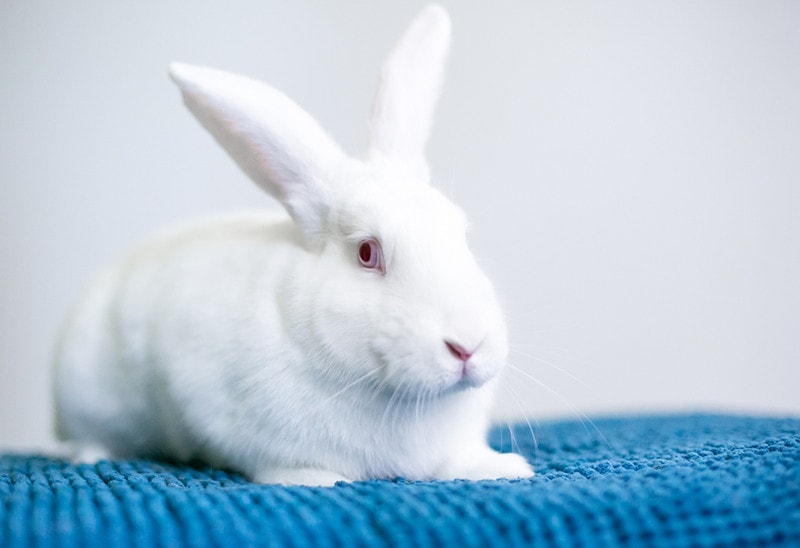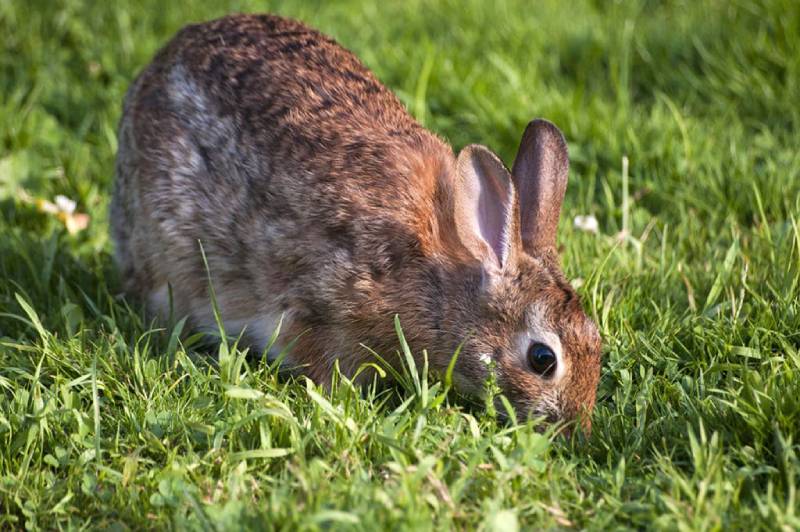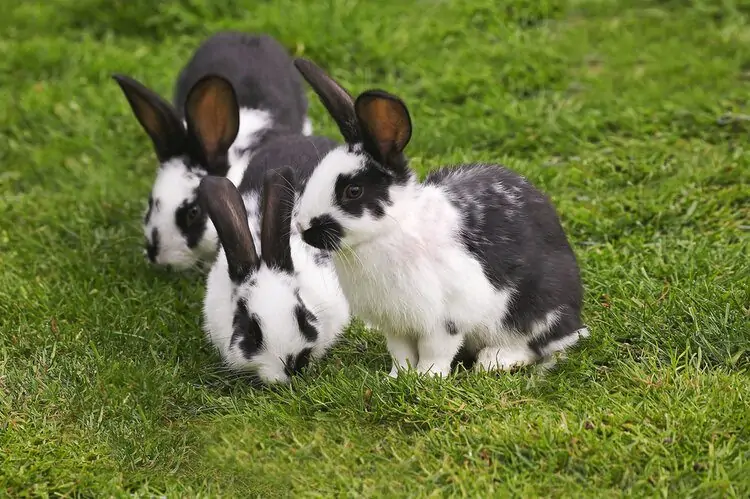Alaska Rabbit: Info, Care, Diet, Pictures & More

Updated on
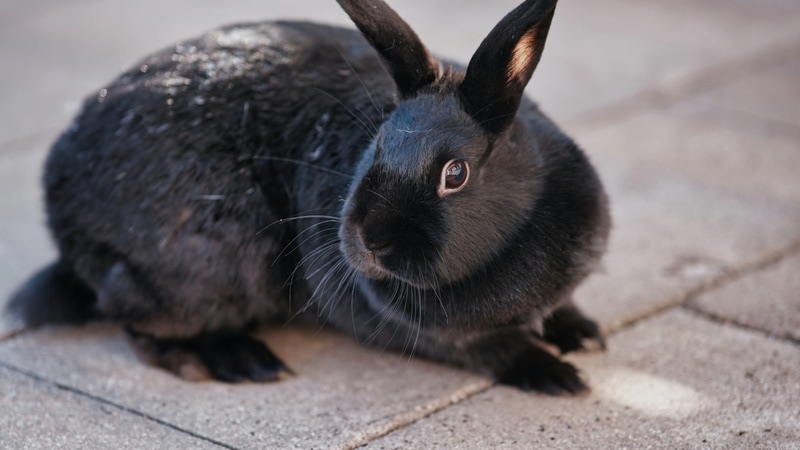
Contrary to its name, the Alaska Rabbit originated in Germany. The German breeders aimed to produce a rabbit that resembled the white Alaskan Fox. They did this by crossing the Champagne d’Argent, Dutch, Havana, and Himalayan, but the outcome was a stunning, black rabbit with a distinctively dense coat. This new rabbit was not modified further and subsequently became the Alaska Rabbit.
Keep reading below to discover more about this cute and wonderful mistake that is now a popular pet today.
| Size: | Medium |
| Weight: | 7–9 pounds |
| Lifespan: | 7- 10 years |
| Similar Breeds: | French Angora, Dutch Havana, Himalayan, Harlequin, American Sable, Belgian Hare |
| Suitable for: | Families, children and teenagers, beginners, and experienced |
| Temperament: | Social, friendly, affectionate, warm-hearted |
The most striking feature of the Alaska is its thick, glossy black coat, which makes them instantly recognizable. When you look at the root of the fur, it is usually a rich slate blue hue, but as it gets closer to the surface, it turns jet black. The pads of the paws, the belly, and the nose are often also matte black.
The Alaska is a medium-sized rabbit breed that is calm, loving, and trainable, and they love to be their owners just as much as their owners enjoy time with them. They are also valued for their docile nature, which makes them ideal pets for children and first-time bunny owners.
Alaska Rabbit Characteristics
 How Much Do These Rabbits Cost?
How Much Do These Rabbits Cost?
The Alaska is a popular breed and isn’t considered rare, which makes them relatively easy to acquire. If you can find a local breeder, you’ll pay $30 to $70 for an Alaska Rabbit. You may be able to find one at a shelter to adopt for cheaper.
It is important to remember that the rabbit’s initial cost is not the only expense. You will need to consider costs for all your care and equipment for your new rabbit. These costs include food, bedding, a hutch, and litter.

Temperament & Intelligence of the Alaska Rabbit
Alaska Rabbits are known for their docile nature. They are calm and laid back, but they are also playful and affectionate. They don’t usually show any aggression and are generally well-tempered. However, they can be a bit skittish initially and must be handled with care and a soft voice to gain your trust.
They are also very intelligent bunnies. You can train the rabbit to come to you when you call it, do small tricks, figure out its litter box, and have it sleeping on your lap in no time. Alaska Rabbits are entertaining pets and great show animals.

Do These Rabbits Make Good Pets?👪
Alaska Rabbits make excellent pets and are suitable for just about any family, even if it’s your first time owning a bunny. They are great with kids as they are well-tempered and generally calm. They won’t scratch or nip as long as they are handled correctly.
As we mentioned, they can be a little skittish initially, so you will need to earn their trust. This is especially important for young children who are eager to pull it out of its cage for cuddles.
Does This Rabbit Get Along With Other Pets?
Alaska Rabbits generally get along with other pets, but it helps significantly if they are raised together. It is also possible to adopt an Alaska Rabbit and slowly introduce them to your other pets and vice versa.
It will also depend on what type of pets you have, what temperament they have, and whether or not they are well socialized. For example, you may have a dog with a high prey drive, and while it may show little interest in your rabbit while it is in the hutch if you decide to take it out, it may mistake it for prey and go after it. Some cats will be aloof and uninterested, while others may try to interact with the bunny.
If you have other rabbits, they may fight when introduced, but with a slow introduction, they will usually get along.
Things to Know When Owning an Alaska Rabbit
Food & Diet Requirements🥕
Alaskas require a steady supply of fresh hay. Hay should make up about 70% of your rabbit’s diet. Premium rabbit pellets are also essential, and you can supplement their diet with leafy, green vegetables. Your rabbit may also enjoy snacking on carrots, broccoli, and fruit like apples and bananas.
Habitat & Hutch Requirements🏠
You can keep your Alaska Rabbit inside or outside but be sure to provide access to a safe space where it can feel protected and enjoy the sunshine. Shade is also important for your rabbit to retreat to. If you choose to keep your rabbit outside, the hutch should be weatherproof and waterproof.
Alaska rabbits are typically under 10 pounds in weight and are medium size. A hutch measuring 6′ x 2′ x 2′ or a little larger is recommended for an Alaska Rabbit. If you have more than one rabbit, you can double the size of the hutch. The rule of thumb is that it should be able to perform three hops from end to end.
Your rabbit’s hutch should include 1–2 inches of quality paper-based bedding, hiding spots, a litter box, a water bottle, a pellet dish, and toys.
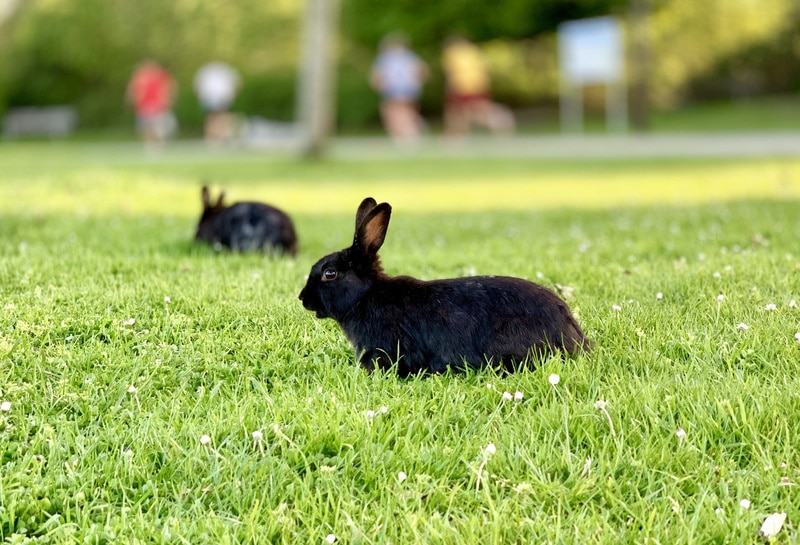
Exercise & Sleeping Needs🐇
An Alaska Rabbit should receive 3 to 5 hours of exercise outside of its hutch daily. They are usually more active in the morning and night, so these are good times for play sessions. They enjoy ramps to run on, buckets of hay to jump in, and cardboard tubes to run through.
Alaskan rabbits require 8 to 9 hours of sleep every night, but with their day naps included, they can sleep for up to 14 hours daily.
Training 🥎
Due to their intelligence and eagerness, training is simpler than it is for most other breeds, and training them to do new tricks is a great way to bond. You can teach your rabbit to target or put its nose in a fixed location as a starting point for training and use a short stick with a tiny ball on one end. Give the rabbit a treat when they touch the ball with their nose after you show it to them. With a little perseverance, they can be taught to navigate agility courses and perform commands like fetch, leap, and spin.
Bear in mind that rabbits are as smart as dogs and cats and will become better pets due to your dedication to training them.
Grooming✂️
The thick fur coats of Alaska Rabbits should be groomed 3–4 times a week to avoid matting, but Alaska Rabbits with extra-thick fur might benefit from daily combing to keep their coats shiny and healthy. To keep their nails, teeth, and coats in good condition, it’s also advised to have them professionally groomed every three months.
Lifespan and Health Conditions🏥
Alaskan rabbits typically live for 7–10 years, which is a long lifetime. Like any pet, your rabbit will live longer if you take good care of it.
Like other breeds, the Alaska Rabbit can be immunized against myxomatosis and viral hemorrhagic disease (VHD), which have a high risk of death. Additionally, you can regularly treat your rabbit for fleas, ticks, and worms if you plan on letting it spend time outside.
Maintaining good dental health is essential to preventing your rabbit’s teeth from overgrowing. Give your pet plenty of high-quality hays and a diet rich in fiber and green vegetables like kale and cabbage. You can also provide rabbits access to chew toys that are safe for them.
- VHD (viral hemorrhagic disease)
- Myxomatosis
- Rotavirus
- Enterotoxemia
- Tyzzer’s disease
- Colibacillosis
- Proliferative enteropathy
- Hairballs
- Tapeworm
- Roundworm
- Pinworm
 Male vs Female
Male vs Female
Male Alaska Rabbits are calmer, less aggressive, and less territorial than females. However, unneutered males tend to mark their territory and “hump” things. Male rabbits are generally recommended as a preference for first-time owners.
The 3 Little-Known Facts About Alaska Rabbits
1. It was bred to save Alaskan Foxes
The Alaska Rabbit Was Originally Bred For Its Fur, Which Helped Ease the Burden of Trapping Alaskan Foxes.
2. It used to be extinct
Before Being Reintroduced by Breeders in 1972, the Alaska Rabbit Went Extinct.
3. They were recognized by ARBA…and then unrecognized again
In the Middle of the 1970s, the American Rabbit Breeders Association (ARBA) Recognized the Alaska Rabbit. However, They Later Withdrew That Recognition.
Final Thoughts
The Alaska Rabbit was bred almost by accident when breeders tried to replicate the fur of the Alaskan Fox. It was spared its coat when the breeders decided to leave it alone, so a beautiful and affectionate pet rabbit was born. These rabbits are known to be docile, calm, affectionate, and intelligent. They make great family pets and are a great breed for a first-time owner. Alaska Rabbits are generally easy to care for. They need a large hutch, fresh hay and water, a hiding spot, some toys, and of course, some love and attention. Along with a quality diet, meeting their needs can help Alaska Rabbits live long and happy lives.
Featured Image Credit to: Md. Ershad Ali, Shutterstock
 How Much Do These Rabbits Cost?
How Much Do These Rabbits Cost?